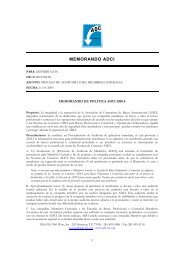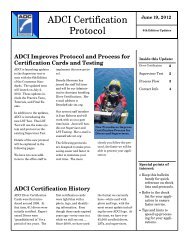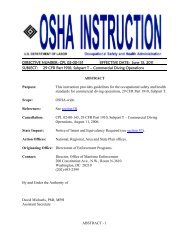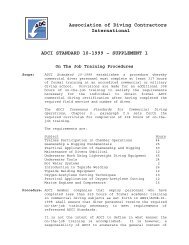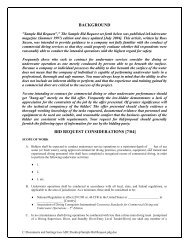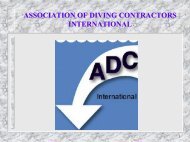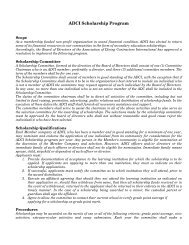Fatal Accident Onboard â MV âGEOSUNDâ
Fatal Accident Onboard â MV âGEOSUNDâ
Fatal Accident Onboard â MV âGEOSUNDâ
Create successful ePaper yourself
Turn your PDF publications into a flip-book with our unique Google optimized e-Paper software.
SAFETY BULLETIN<br />
Nedre Åstveit 12<br />
NO-5106 Øvre Ervik<br />
Bergen Norway<br />
Telephone: +47 55 25 20 00<br />
Telefax: +47 55 25 20 01<br />
Email: norway@dofsubsea.com<br />
Bulletin No: DSN-HSEQ-S99-08-0001<br />
Date: 10.03.2008<br />
Issued by: DSN-HSEQ<br />
SAFETY BULLETIN<br />
Subject: <strong>Fatal</strong> <strong>Accident</strong> <strong>Onboard</strong> – <strong>MV</strong> ”GEOSUND” in<br />
connection with the operation of the A-frame based LARS<br />
system with AHC<br />
Compliance Level:<br />
Department:<br />
Information<br />
ROV Operations<br />
The Incident<br />
M/V Geosund arrived in the floating dock at Fredericia Skibsværft, Denmark around 08.20<br />
hrs. on February 9 th 2008 and the vessel was scheduled to dock at 09.00 hrs on the same<br />
morning.<br />
During the docking process, the ROV crew consisting of 7 persons were working on the ROV<br />
spread inside the hangar on port side of the vessel. This work was mainly to undock the ROV<br />
from the TMS unit and to cut out and re-terminate a 50 – 70 meter section of the umbilical on<br />
the ROV winch.<br />
Prior to the incident, the ROV had been separated from the TMS and both units were resting<br />
on the base platform in the hangar, with the TMS located just underneath the Docking Head<br />
which was situated 2,5 m above the top of the TMS. The ROV was located adjacent to the<br />
TMS towards the port side of the hangar.<br />
Around 10.30 hrs. a total power black out occurred onboard the vessel due to lack of cooling<br />
water supply to the auxiliary engines. The fatality happened at the time of the black out when<br />
the TMS unit made a sudden and significant vertical movement (approximately 2,5 m) until it<br />
was stopped by the Docking Head overhead. The ROV Senior Supervisor was standing on<br />
top of the TMS with the aim to assist with the pull-out of the umbilical. He was trapped and<br />
subjected to a massive force of 13,7 TE between the TMS and the Docking Head.<br />
At the time of the accident, the ROV Supervisor was standing on a small service platform on<br />
the side of the TMS facing the accommodation and he was thrown clear, landing on the base<br />
platform, with no apparent injuries.<br />
DSN-HSEQ-S99-08-0001<strong>Fatal</strong> <strong>Accident</strong> <strong>Onboard</strong> – <strong>MV</strong> ”GEOSUND” in connection with the operation of the A-frame based LARS system with AHC
The other ROV crew members were located in the following positions:<br />
One person was strategically located between the ROV/TMS and the accommodation<br />
operating the remote control for the LARS system,<br />
One person was located on the ROV winch deck on top of the ROV hangar, adjusting the<br />
position of the transversal crane to keep it well clear of the LARS system,<br />
Two persons were located on the inboard side of the TMS, pulling out slack on the umbilical<br />
from the umbilical winch,<br />
One ROV trainee was observing the operation from a safe position near the centre of the<br />
hangar.<br />
The accident was sudden and the witnesses of the tragedy estimated the uncontrolled and<br />
rapid spooling of the winch in the order of 2 – 3 seconds.<br />
DSN-HSEQ-S99-08-0001<strong>Fatal</strong> <strong>Accident</strong> <strong>Onboard</strong> – <strong>MV</strong> ”GEOSUND” in connection with the operation of the A-frame based LARS system with AHC
Facts and Observations from the Investigation<br />
There were no Offshore Manager (OM) assigned onboard M/v Geosund after the vessels<br />
departure from Bergen to Denmark<br />
The ROV crew had allegedly received Permission To Work at heights from the bridge.<br />
There were no indications that the ROV crew were not wearing the correct PPE for this<br />
type of operation.<br />
The ROV crew were working on the ROV spread during the de-ballasting of the floating<br />
dock.<br />
Relevant crew allegedly knew that a power black out would take place during the dry<br />
docking process, although the exact timing of this black out and the permanent loss of<br />
440 V AC was not known to some key personnel beforehand.<br />
The accident occurred at the same time as the power black out. The ROV winch spooled<br />
in the umbilical instantly and uncontrolled, lifting the TMS module vertically up towards the<br />
Docking Head, causing the fatality.<br />
The launch and recovery procedure states that the winch shall be set in ST-BY MODE on<br />
the remote/ main control, when personnel were working on TMS.<br />
The ROV Supervisor was standing on top of the TMS with the aim to assist the pull-out of<br />
the umbilical of which c.a. 5m had been slacked off when the incident occurred. He was<br />
trapped and his body exposed to a massive force of 13,7 Te between the TMS and the<br />
Docking Head.<br />
Due to power cut the operation of the Emergency Stop had no effect.<br />
It is anticipated that the task of spooling off (approximately 50 m) of umbilical in order to<br />
re-terminate had to be completed prior to docking – this may have lead to time pressure.<br />
It has been noted that Assistant ROV Supervisor was in process of lashing down the TMS<br />
at the time of the incident.<br />
Technical Error<br />
Testing and trouble shooting have confirmed that there were serious technical<br />
discrepancies on the LARS system resulting in a chain of events having a direct effect on<br />
the accident.<br />
The mechanisms with effect, cause and corrective measures are presented below. Note<br />
that all of the six mechanisms described below had to occur simultaneously for the erratic<br />
winch behavior to occur.<br />
DSN-HSEQ-S99-08-0001<strong>Fatal</strong> <strong>Accident</strong> <strong>Onboard</strong> – <strong>MV</strong> ”GEOSUND” in connection with the operation of the A-frame based LARS system with AHC
1. The isolation valve fails to close:<br />
a. Effect:<br />
• The motor will have access to hydraulic power.<br />
b. Cause:<br />
• Incorrect wiring.<br />
c. Corrective measure:<br />
• Wiring done according to original drawing.<br />
• The valve is hardwired into the emergency stop circuit (De-energizing).<br />
2. The bypass valve fail to open:<br />
a. Effect:<br />
• Potentially full pressure differential over the motor with failure on the<br />
isolation valve, thus enabling the motor to produce maximum torque.<br />
b. Cause:<br />
• An error in the motor controller (HNC) software fails to de-energize the<br />
bypass valve when an emergency stop is triggered when operating the<br />
winch from the radio remote or the operator panel.<br />
c. Corrective measure:<br />
• Software for motor controller updated. Bypass valve will be de-energized as<br />
originally intended when the winch is rotating during an emergency stop.<br />
3. The brake fails to engage within reasonable time:<br />
a. Effect:<br />
• The brake can not stop winch motion within reasonable time.<br />
b. Cause:<br />
• The main controller (PC104) software will not engage the brake until a brake<br />
engage request is given from the motor controller (HNC) software. The<br />
motor controller software will not give such a request in all situations.<br />
c. Corrective measure:<br />
• Software for motor controller updated. Brake on command (De-energizing)<br />
will be provided immediately in case of an emergency stop.<br />
• Software for main controller updated. Brake on command (De-energizing)<br />
will be provided immediately in case of an emergency stop, independent of<br />
the motor controller.<br />
• Brake control is hardwired into the emergency stop circuit (De-energizing).<br />
4. The displacement (Swivel angle) of the motor is sufficient to create winch pull:<br />
a. Effect:<br />
• The motors had a displacement creating torque so that the winch could pull<br />
inn.<br />
b. Cause:<br />
• To avoid the load from dropping during a normal emergency stop, the<br />
displacement of the motors is set at a fixed value. As long as the isolation<br />
valve is closed as it should be in case of an emergency stop, the winch can<br />
only give a static torque and cannot hoist any load as the supply of high<br />
DSN-HSEQ-S99-08-0001<strong>Fatal</strong> <strong>Accident</strong> <strong>Onboard</strong> – <strong>MV</strong> ”GEOSUND” in connection with the operation of the A-frame based LARS system with AHC
pressure oil is cut by the isolation valve. When the bypass valve opens,<br />
there will be no significant pressure differential over the motor, and the<br />
winches ability to also create a static torque will be lost.<br />
c. Corrective measure:<br />
• None. Displacement is required to prevent the load from dropping during an<br />
ordinary emergency stop. Investigations regarding alternatives ongoing.<br />
This is to be tested at the for implementation in a coming release of new<br />
motor controller software.<br />
5. The winch has a speed signal different from zero:<br />
a. Effect:<br />
• Winch hoisting for a longer period of time after an emergency stop.<br />
b. Cause:<br />
• In the original motor controller software, the brake did apply quickly at an<br />
emergency stop at zero speed, but not when the speed was different than<br />
zero.<br />
c. Corrective measure:<br />
• As for 3.<br />
6. Hydraulic power is available:<br />
a. Effect:<br />
• Winch motion possible.<br />
b. Cause:<br />
• Pumps do not momentarily stop rotating due to rotating inertia.<br />
• Hydraulic energy is stored in accumulators.<br />
• Hydraulic energy is stored in the system due to the flexibility of pipes, hoses<br />
and the oil itself.<br />
c. Corrective measure:<br />
• A valve on the accumulator will be installed to cut the connection to the main<br />
line, and relieve the energy into the return line. The valve will be hardwired<br />
into the emergency stop circuit (De-energizing).<br />
The following summarizes the applied measures:<br />
• Wiring of isolation valve corrected to comply with original drawing.<br />
• Isolation valves hardwired into the emergency stop circuit.<br />
• Brake control valve hardwired into the emergency stop circuit.<br />
• Main controller software updated to request brake on upon an emergency<br />
stop.<br />
• Motor controller software updated to request brake on upon an emergency<br />
stop.<br />
• Motor controller software updated to de-energize bypass valve upon an<br />
emergency stop.<br />
DSN-HSEQ-S99-08-0001<strong>Fatal</strong> <strong>Accident</strong> <strong>Onboard</strong> – <strong>MV</strong> ”GEOSUND” in connection with the operation of the A-frame based LARS system with AHC
The applied measures will minimize the probability of any failure to engage the brake or<br />
failure to close the isolation valve during an emergency stop by the introduction of<br />
modifications to the software and electronic hardware.<br />
The duration of any significant dynamic winch pull will also be minimized as the bypass valve<br />
short circuits the hydraulic motor shortly after an emergency stop.<br />
Further, the following measure will be applied at a later stage due to lead time of<br />
components:<br />
• The accumulator will be cut off from the main line, and the stored high<br />
pressure oil will be discharged to tank through a hydraulic valve being<br />
hardwired into the emergency stop circuit.<br />
DSN-HSEQ-S99-08-0001<strong>Fatal</strong> <strong>Accident</strong> <strong>Onboard</strong> – <strong>MV</strong> ”GEOSUND” in connection with the operation of the A-frame based LARS system with AHC


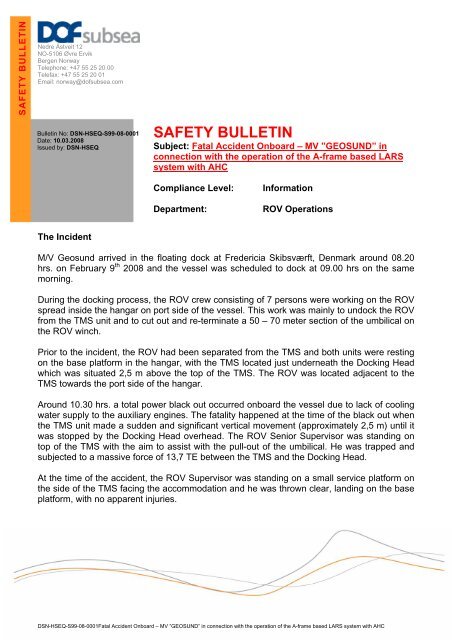
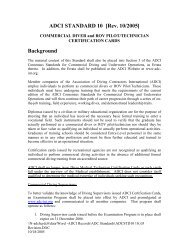
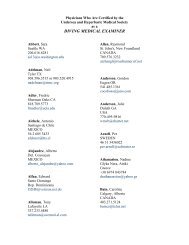
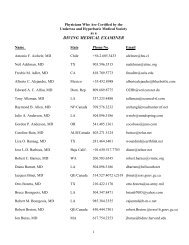
![SOLICITUD MEMBRESIA ASOCIADO [Rev 06/08] - Association of ...](https://img.yumpu.com/48291988/1/190x245/solicitud-membresia-asociado-rev-06-08-association-of-.jpg?quality=85)

